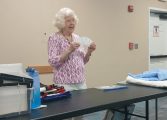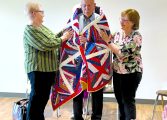“If a ventriloquist is good, you will barely notice the ventriloquist – you will be looking at the figure. It is a mixture of talent, education and learning,” said Westmoreland. “If you can’t make people laugh you’re just another guy with a doll.”
Talking without moving one’s lips may seem difficult. Westmoreland described the difficulty with labial sounds, or letters ventriloquists must pronounce using their lips, including f, v, p, b and m. With a less skilled ventriloquist this would be obvious. But like finger exercises on the piano, Westmoreland said, it just takes practice.
Westmoreland, who has performed since getting his first puppet at 10, entered talent shows, competitions, and joined a community theater group while in middle school. He has continued to entertain with a variety of puppets for the last 38 years, and went professional in 2009.
Ventriloquists now refer to their dummies as figures or puppets. Earlier puppets were almost grotesque, with larger heads and wide, exaggerated carved features. Nowadays they are still proportioned the same, but the features are made to look friendlier and more animated. This still does not give comfort to those who have a legitimate fear of them.
At a basic level, Westmoreland said, few could be afraid of the figures unless they believed in the supernatural taking over the puppet, a notion forged in the culture of horror movies. “There are those who really are afraid of them,” he said. He took a Laurel and Hardy puppet and showed one basic string that manipulated the opening and closing of the mouth. “These are very simple puppets,” he said.
For years while in the military, he used soft puppets similar to Jim Henson’s Muppets. The only one he uses these days is Grandpa Reese, who stands over 5 feet and is manipulated by hand gestures inside.
Graduating to the next level, Westmoreland then had a Charlie McCarthy, which was much smaller than his current puppets. Slightly larger than Charlie was his dapper young man Scotty; but he later replaced Scotty with a larger carved wooden version. Old Scotty was converted into a petite dark-haired Suzy Q – Scotty’s sister.
A ventriloquist has to learn to be a master puppeteer as well as a skilled ventriloquist. Westmoreland took Suzy Q apart to reveal a head on a stick with a couple of levers for manipulating the mouth and turning the head. Scotty, who is larger, has more levers to manipulate the head, eyebrows, eyes and mouth. Country Boy Clem has the most, with around six levers. Westmoreland showed his ability to work those levers with one hand. Anyone would have to have skill to manipulate the puppet and trying not move one’s lips while talking. It definitely takes practice to make it look flawless.
Tim Cowles is one of the tops in creating ventriloquist figures today, and Westmoreland is among many who respect his painstaking craftsmanship. The puppets or figures are not inexpensive, costing an average of $300 to $500. That is why they are often transported in a padded trunk. Westmoreland crafted some of his traveling cases from old Samsonite suitcases, laying inside the proper padding to hold them in place, after folding the puppets a certain way and laying them inside face up. To a ventriloquist, they are a stock and trade, but on stage they become a character he or she has created.
Ventriloquism has been on the upswing over the years with the television show America’s Got Talent. Two ventriloquists have won the title, and this year 12-year-old Darci Lynne Farmer blew the audience away with her routine. Westmoreland was one of those who took a shot at the auditions when living in Atlanta a few years ago.
“I didn’t make it but I had fun,” he said. “It was a great experience.”




